2007 CHEVROLET EQUINOX stop start
[x] Cancel search: stop startPage 11 of 492
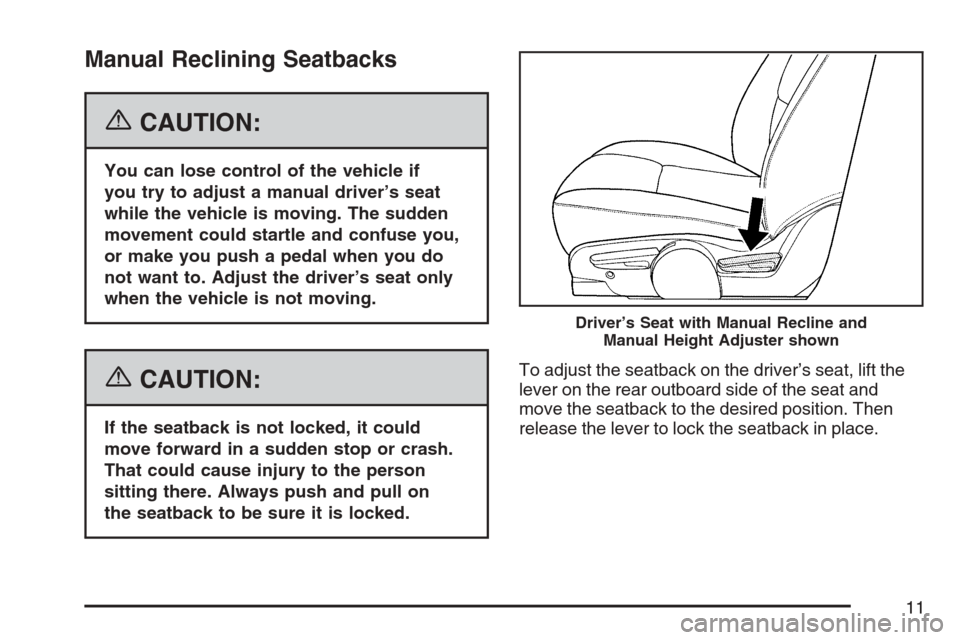
Manual Reclining Seatbacks
{CAUTION:
You can lose control of the vehicle if
you try to adjust a manual driver’s seat
while the vehicle is moving. The sudden
movement could startle and confuse you,
or make you push a pedal when you do
not want to. Adjust the driver’s seat only
when the vehicle is not moving.
{CAUTION:
If the seatback is not locked, it could
move forward in a sudden stop or crash.
That could cause injury to the person
sitting there. Always push and pull on
the seatback to be sure it is locked.To adjust the seatback on the driver’s seat, lift the
lever on the rear outboard side of the seat and
move the seatback to the desired position. Then
release the lever to lock the seatback in place.
Driver’s Seat with Manual Recline and
Manual Height Adjuster shown
11
Page 114 of 492
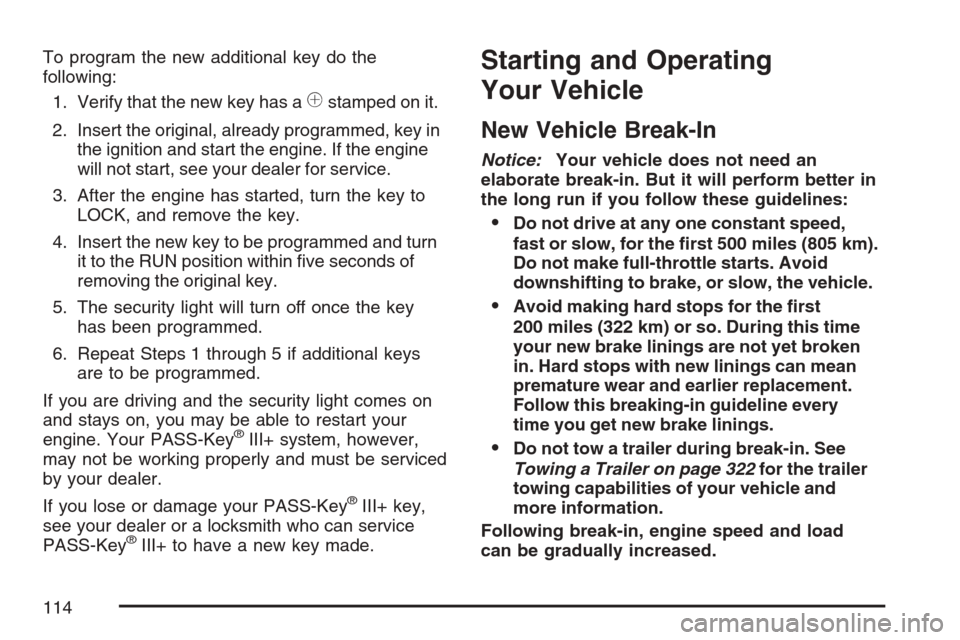
To program the new additional key do the
following:
1. Verify that the new key has a
1stamped on it.
2. Insert the original, already programmed, key in
the ignition and start the engine. If the engine
will not start, see your dealer for service.
3. After the engine has started, turn the key to
LOCK, and remove the key.
4. Insert the new key to be programmed and turn
it to the RUN position within �ve seconds of
removing the original key.
5. The security light will turn off once the key
has been programmed.
6. Repeat Steps 1 through 5 if additional keys
are to be programmed.
If you are driving and the security light comes on
and stays on, you may be able to restart your
engine. Your PASS-Key
®III+ system, however,
may not be working properly and must be serviced
by your dealer.
If you lose or damage your PASS-Key
®III+ key,
see your dealer or a locksmith who can service
PASS-Key
®III+ to have a new key made.
Starting and Operating
Your Vehicle
New Vehicle Break-In
Notice:Your vehicle does not need an
elaborate break-in. But it will perform better in
the long run if you follow these guidelines:
Do not drive at any one constant speed,
fast or slow, for the �rst 500 miles (805 km).
Do not make full-throttle starts. Avoid
downshifting to brake, or slow, the vehicle.
Avoid making hard stops for the �rst
200 miles (322 km) or so. During this time
your new brake linings are not yet broken
in. Hard stops with new linings can mean
premature wear and earlier replacement.
Follow this breaking-in guideline every
time you get new brake linings.
Do not tow a trailer during break-in. See
Towing a Trailer on page 322for the trailer
towing capabilities of your vehicle and
more information.
Following break-in, engine speed and load
can be gradually increased.
114
Page 116 of 492
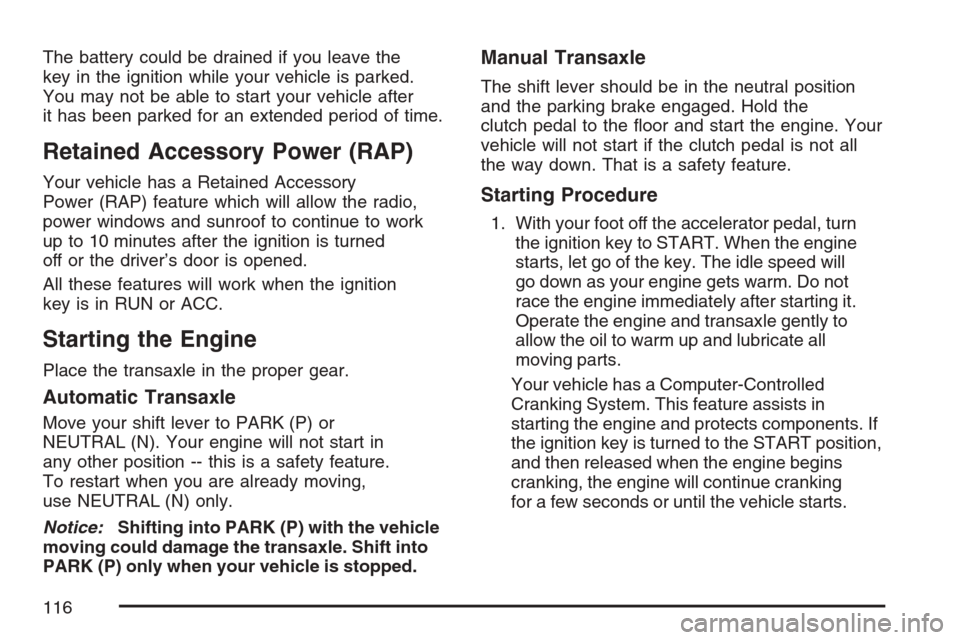
The battery could be drained if you leave the
key in the ignition while your vehicle is parked.
You may not be able to start your vehicle after
it has been parked for an extended period of time.
Retained Accessory Power (RAP)
Your vehicle has a Retained Accessory
Power (RAP) feature which will allow the radio,
power windows and sunroof to continue to work
up to 10 minutes after the ignition is turned
off or the driver’s door is opened.
All these features will work when the ignition
key is in RUN or ACC.
Starting the Engine
Place the transaxle in the proper gear.
Automatic Transaxle
Move your shift lever to PARK (P) or
NEUTRAL (N). Your engine will not start in
any other position -- this is a safety feature.
To restart when you are already moving,
use NEUTRAL (N) only.
Notice:Shifting into PARK (P) with the vehicle
moving could damage the transaxle. Shift into
PARK (P) only when your vehicle is stopped.
Manual Transaxle
The shift lever should be in the neutral position
and the parking brake engaged. Hold the
clutch pedal to the �oor and start the engine. Your
vehicle will not start if the clutch pedal is not all
the way down. That is a safety feature.
Starting Procedure
1. With your foot off the accelerator pedal, turn
the ignition key to START. When the engine
starts, let go of the key. The idle speed will
go down as your engine gets warm. Do not
race the engine immediately after starting it.
Operate the engine and transaxle gently to
allow the oil to warm up and lubricate all
moving parts.
Your vehicle has a Computer-Controlled
Cranking System. This feature assists in
starting the engine and protects components. If
the ignition key is turned to the START position,
and then released when the engine begins
cranking, the engine will continue cranking
for a few seconds or until the vehicle starts.
116
Page 117 of 492
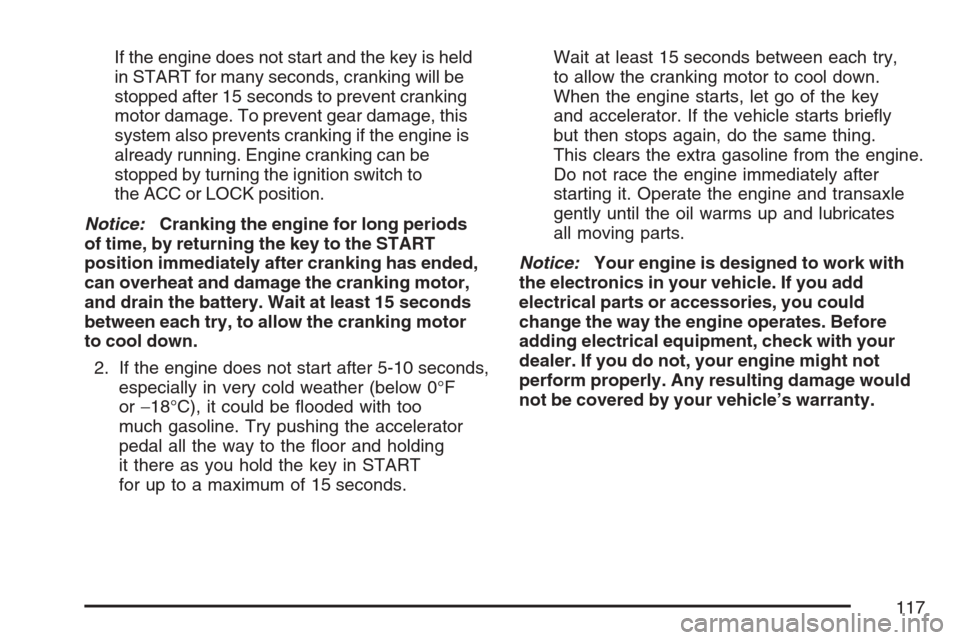
If the engine does not start and the key is held
in START for many seconds, cranking will be
stopped after 15 seconds to prevent cranking
motor damage. To prevent gear damage, this
system also prevents cranking if the engine is
already running. Engine cranking can be
stopped by turning the ignition switch to
the ACC or LOCK position.
Notice:Cranking the engine for long periods
of time, by returning the key to the START
position immediately after cranking has ended,
can overheat and damage the cranking motor,
and drain the battery. Wait at least 15 seconds
between each try, to allow the cranking motor
to cool down.
2. If the engine does not start after 5-10 seconds,
especially in very cold weather (below 0°F
or−18°C), it could be �ooded with too
much gasoline. Try pushing the accelerator
pedal all the way to the �oor and holding
it there as you hold the key in START
for up to a maximum of 15 seconds.Wait at least 15 seconds between each try,
to allow the cranking motor to cool down.
When the engine starts, let go of the key
and accelerator. If the vehicle starts brie�y
but then stops again, do the same thing.
This clears the extra gasoline from the engine.
Do not race the engine immediately after
starting it. Operate the engine and transaxle
gently until the oil warms up and lubricates
all moving parts.
Notice:Your engine is designed to work with
the electronics in your vehicle. If you add
electrical parts or accessories, you could
change the way the engine operates. Before
adding electrical equipment, check with your
dealer. If you do not, your engine might not
perform properly. Any resulting damage would
not be covered by your vehicle’s warranty.
117
Page 120 of 492
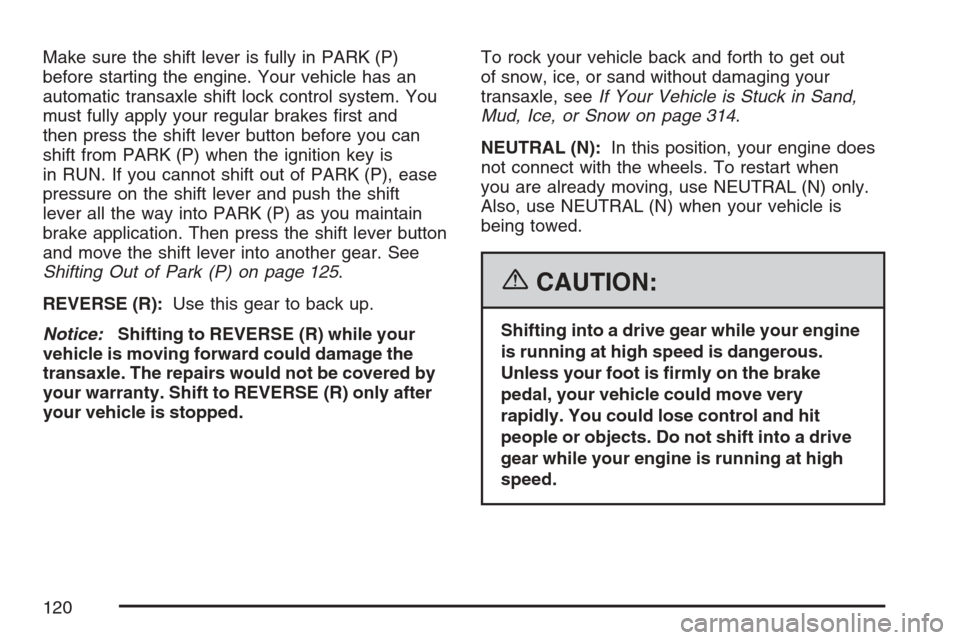
Make sure the shift lever is fully in PARK (P)
before starting the engine. Your vehicle has an
automatic transaxle shift lock control system. You
must fully apply your regular brakes �rst and
then press the shift lever button before you can
shift from PARK (P) when the ignition key is
in RUN. If you cannot shift out of PARK (P), ease
pressure on the shift lever and push the shift
lever all the way into PARK (P) as you maintain
brake application. Then press the shift lever button
and move the shift lever into another gear. See
Shifting Out of Park (P) on page 125.
REVERSE (R):Use this gear to back up.
Notice:Shifting to REVERSE (R) while your
vehicle is moving forward could damage the
transaxle. The repairs would not be covered by
your warranty. Shift to REVERSE (R) only after
your vehicle is stopped.To rock your vehicle back and forth to get out
of snow, ice, or sand without damaging your
transaxle, seeIf Your Vehicle is Stuck in Sand,
Mud, Ice, or Snow on page 314.
NEUTRAL (N):In this position, your engine does
not connect with the wheels. To restart when
you are already moving, use NEUTRAL (N) only.
Also, use NEUTRAL (N) when your vehicle is
being towed.
{CAUTION:
Shifting into a drive gear while your engine
is running at high speed is dangerous.
Unless your foot is �rmly on the brake
pedal, your vehicle could move very
rapidly. You could lose control and hit
people or objects. Do not shift into a drive
gear while your engine is running at high
speed.
120
Page 178 of 492
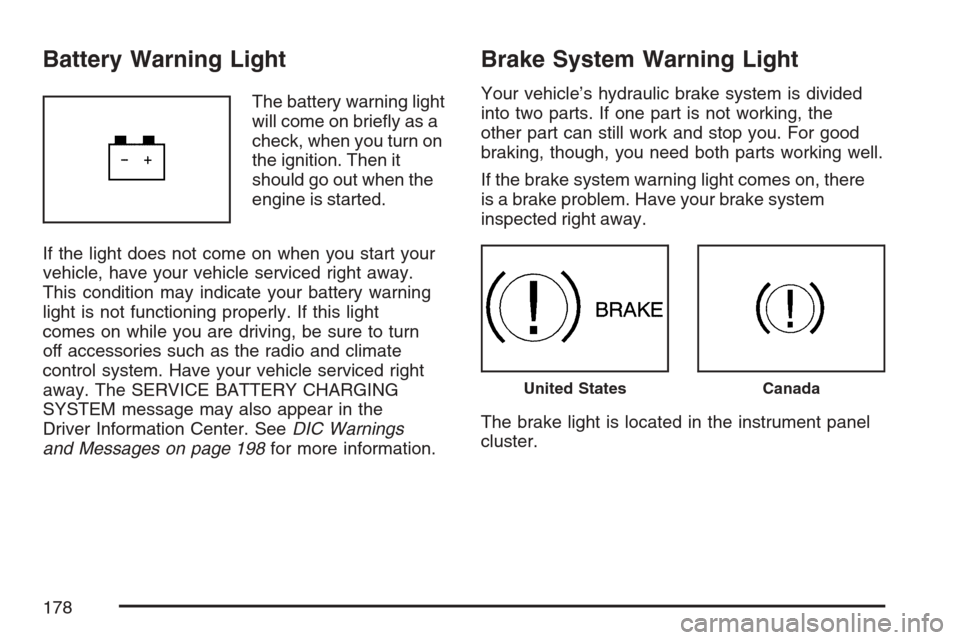
Battery Warning Light
The battery warning light
will come on brie�y as a
check, when you turn on
the ignition. Then it
should go out when the
engine is started.
If the light does not come on when you start your
vehicle, have your vehicle serviced right away.
This condition may indicate your battery warning
light is not functioning properly. If this light
comes on while you are driving, be sure to turn
off accessories such as the radio and climate
control system. Have your vehicle serviced right
away. The SERVICE BATTERY CHARGING
SYSTEM message may also appear in the
Driver Information Center. SeeDIC Warnings
and Messages on page 198for more information.
Brake System Warning Light
Your vehicle’s hydraulic brake system is divided
into two parts. If one part is not working, the
other part can still work and stop you. For good
braking, though, you need both parts working well.
If the brake system warning light comes on, there
is a brake problem. Have your brake system
inspected right away.
The brake light is located in the instrument panel
cluster.
United StatesCanada
178
Page 180 of 492
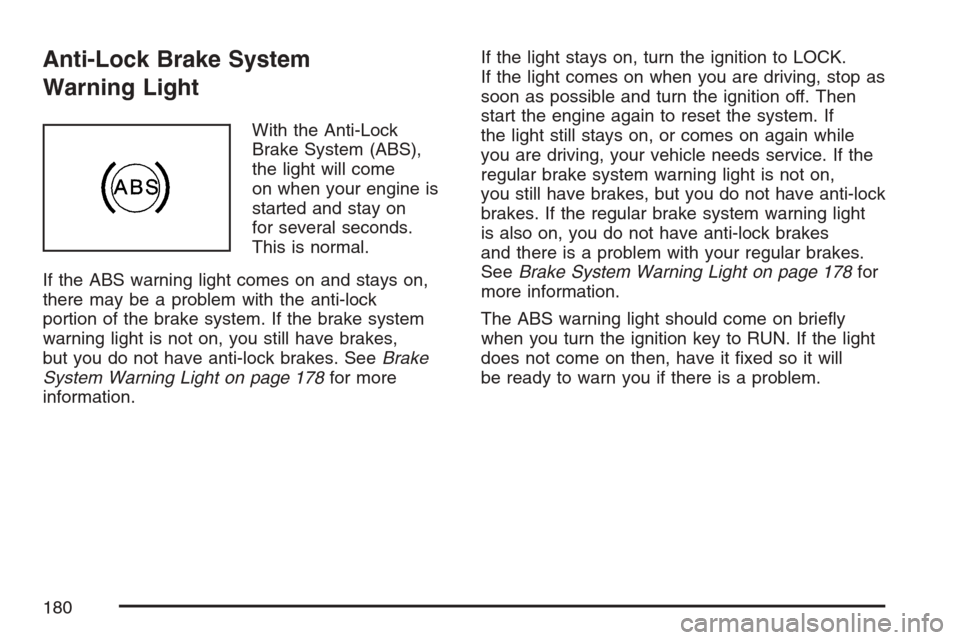
Anti-Lock Brake System
Warning Light
With the Anti-Lock
Brake System (ABS),
the light will come
on when your engine is
started and stay on
for several seconds.
This is normal.
If the ABS warning light comes on and stays on,
there may be a problem with the anti-lock
portion of the brake system. If the brake system
warning light is not on, you still have brakes,
but you do not have anti-lock brakes. SeeBrake
System Warning Light on page 178for more
information.If the light stays on, turn the ignition to LOCK.
If the light comes on when you are driving, stop as
soon as possible and turn the ignition off. Then
start the engine again to reset the system. If
the light still stays on, or comes on again while
you are driving, your vehicle needs service. If the
regular brake system warning light is not on,
you still have brakes, but you do not have anti-lock
brakes. If the regular brake system warning light
is also on, you do not have anti-lock brakes
and there is a problem with your regular brakes.
SeeBrake System Warning Light on page 178for
more information.
The ABS warning light should come on brie�y
when you turn the ignition key to RUN. If the light
does not come on then, have it �xed so it will
be ready to warn you if there is a problem.
180
Page 184 of 492
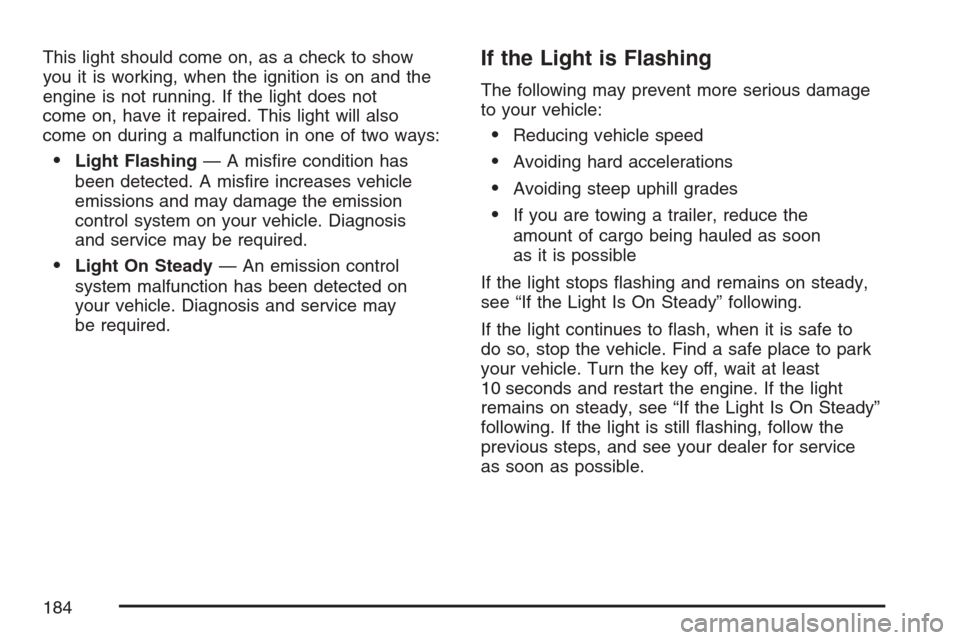
This light should come on, as a check to show
you it is working, when the ignition is on and the
engine is not running. If the light does not
come on, have it repaired. This light will also
come on during a malfunction in one of two ways:
Light Flashing— A mis�re condition has
been detected. A mis�re increases vehicle
emissions and may damage the emission
control system on your vehicle. Diagnosis
and service may be required.
Light On Steady— An emission control
system malfunction has been detected on
your vehicle. Diagnosis and service may
be required.
If the Light is Flashing
The following may prevent more serious damage
to your vehicle:
Reducing vehicle speed
Avoiding hard accelerations
Avoiding steep uphill grades
If you are towing a trailer, reduce the
amount of cargo being hauled as soon
as it is possible
If the light stops �ashing and remains on steady,
see “If the Light Is On Steady” following.
If the light continues to �ash, when it is safe to
do so, stop the vehicle. Find a safe place to park
your vehicle. Turn the key off, wait at least
10 seconds and restart the engine. If the light
remains on steady, see “If the Light Is On Steady”
following. If the light is still �ashing, follow the
previous steps, and see your dealer for service
as soon as possible.
184